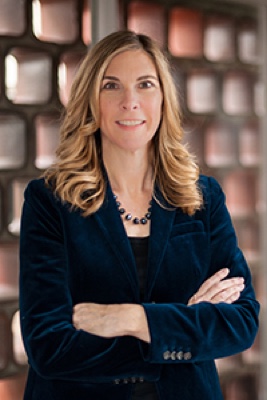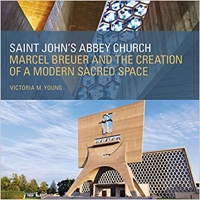What I’m Reading: An Interview with Art Historian Victoria Young

Victoria Young is a professor of modern architectural history and chair of the Art History Department at the University of St. Thomas in St. Paul, Minnesota. She is the author of Saint John’s Abbey Church: Marcel Breuer and the Creation of Modern Sacred Space (University of Minnesota Press, 2014). Her book was included on Architectural Record’s 2014 Book Round Up and it has been heralded in a review by Norman Weinstein for ArchNewsNow as “the first great architectural history of the 21st century.” Young’s interest in monastic sacred space goes back to her 2002 publication about a monastic house in Leicestershire, “A.W.N. Pugin¹s Mount Saint Bernard Abbey: The International Character of England¹s Nineteenth-Century Monastic Revival,” in the journal Nineteenth-Century Art Worldwide.
 Her
current research focuses on contemporary war museum design,
specifically the architectural story of the National WWII Museum in
New Orleans (2003-present), designed by Voorsanger Architects of New
York City.
Her
current research focuses on contemporary war museum design,
specifically the architectural story of the National WWII Museum in
New Orleans (2003-present), designed by Voorsanger Architects of New
York City.
Young is second vice president of the Society of Architectural Historians and has served as a member of Minnesota’s State Historic Review Board and Governor’s Residence Council. She has a B.A. from New York University and M.A. and Ph.D. from the University of Virginia.
What books are you reading now?
I’m reading Victoria: The Queen. An Intimate Biography of the Woman Who Ruled an Empire by Julia Baird (Random House, 2016) because of my interest in London, England, and the United Kingdom, as I’ve studied there in the past, and I teach a study abroad January-term art history survey course there frequently. I’m also reading Unfolded: How Architecture Saved my Life – Bartholomew Voorsanger by Alastair Gordon (Oro Press, 2017). Mr. Voorsanger’s architectural work is now being archived at my department at the University of St. Thomas and it’s fascinating to really know an architect as a person, not just a designer.
What is your favorite history book?
As an architectural historian, I’m drawn toward works that use the built environment to explain relationships among people. One of my favorite writers is Dell Upton of the University of California at Los Angeles and his most recent book, What Can and Can’t Be Said: Race, Uplift, and Monument Building in the Contemporary South (Yale U Press, 2015), is in heavy rotation in my classrooms these days.
Why did you choose history as your career?
I was always the kid reading when I was younger, devouring books about all topics and places. Once I took an art history class in college, I was hooked, and after visiting Chicago and seeing the amazing architecture of that city, including the work of Frank Lloyd Wright, I was hooked. I knew I wanted to become an architectural historian and tell the story of our past through the use of the built environment. I think that everyone can relate to architecture, probably even more so than art, and it’s wonderful to watch my students look more intently at their surroundings because of the time they spend studying architectural history.
What qualities do you need to be a historian?
Historians need to be persistent in the search for information. You shouldn’t be afraid to ask lots of questions of the material you are investigating and the people you interview. Historians must also be broad in their background work. In my research on the National World War II Museum campus in New Orleans, I just can’t read about architecture, I’ve got to think about city planning, WWII history, politics is New Orleans, the history of exhibition design, etc. I also think that every historian needs to be a bit of an introvert and be really comfortable alone in archives or reading historical documents.
Which historical time period do you find to be the most fascinating?
I am fascinated by the Victorians. My research into the 19th-century Trappist monastery of Mount Saint Bernard in Leicestershire, England, hooked me on the time period. There’s so much innovation, so much religious change, and so many wonderful artistic works produced because of it. I would love to be able to time travel and live amongst the Pre-Raphaelite painters in England - Rosetti, Burne-Jones, Millais and others.
Who was your favorite history teacher?
I have been fortunate to have had many favorite teachers over the years, so I can’t single out just one. Architectural history first came alive for me when I was at New York University studying with Carol Krinsky, Sarah Landau, and Mosette Broderick. Their passion and search for excellence inspired me. My time at the University of Virginia continued this path as I was fortunate to study with Richard Guy Wilson, Lisa Reilly, Camille Wells and Kevin Murphy.
What are your hopes for world and social history as a discipline?
I hope that we keep art/architectural history as a vital component of K-12 and college educations. The world is so visual and this language must be analyzed and understood by our students. They “get” the visual and we can provide the historical perspective. I think we both have much to learn from each other!
Do you own any rare history or collectible books? Do you collect artifacts related to history?
I tend to collect books as opposed to artifacts of history. I have an original copy of a 19th-century book of drawings of buildings in Normandy by A.W.N. Pugin’s father, A.C. Pugin, called the Specimens of the Architectural Antiquities of Normandy (1827). The younger Pugin helped his father complete it. And most recently a friend gifted me a Bernard Tschumi drawing of the Parc de la Villette in Paris from the 1980s.
What have you found most rewarding and most frustrating about your career?
I am constantly rewarded by my students. They always help me think through the past in new ways and I am particularly grateful for their input when it comes to my own research interests. Frustrations are minimal but usually revolve around the disparity in funding for research as compared to my colleagues in the sciences.
How has the study of history changed in the course of your career?
I never dreamed as a young girl growing up on a farm in southern Minnesota that history would be something that would sustain my life. I’m thankful every day for the work that I do as a teacher, researcher, and promoter of architectural history. I am also grateful for the positions of leadership it has provided, such as becoming department chair of Art History at St. Thomas and also being a vice president of the Society of Architectural Historians (SAH). I enjoy the ability to get the word out about my discipline beyond the campus walls and look forward to sharing the history of the built environment with all when the SAH annual conference comes to St. Paul in April 2018.
What is your favorite history-related saying? Have you come up with your own?
“Failure is not an Option” – although Gene Kranz was not the person who said this at NASA during the Apollo 13 mission, his character played by Ed Harris was given the line in the movie.
What are you doing next?
My next project is the curating and installation of an exhibition centered on the work of architect Bartholomew Voorsanger. This will open in the Art History Gallery on the campus of St. Thomas in February 2018. This exhibition showcases the designs of Voorsanger Architects of New York City and also the process of creating the archive of their work at St. Thomas over the past two years. I’m also writing a manuscript on the firm’s design of the National World War II Museum in New Orleans, positioning this project within the recent war museums in Poland, Canada, the United Kingdom, and elsewhere.